Best of DesignCon 2017
Several trends were apparent at last week’s DesignCon 2017 conference. Foremost among them was the advance of copper solutions that include wiring as an alternative to PCB traces.
 DesignCon 2017 opened amid a thoroughly drenched Bay Area, but did not deter more than 5,000 attendees to this premier exhibition of leading edge electronic design, technology and components. DesignCon has traditionally been a source of leading technology and trends that points the direction of electronic packaging and performance for years into the future. More than 160 companies featured high-performance, test equipment, design tools, cable assemblies and interconnects including 25 suppliers of electronic connectors. Several new participants, including Foxconn Interconnect Technology (FIT), made their first appearance this year. An exceptionally robust schedule of 105 technical seminars, in addition to sponsored presentations, boot camps and a keynote presentation, were well attended, often to standing room only.
DesignCon 2017 opened amid a thoroughly drenched Bay Area, but did not deter more than 5,000 attendees to this premier exhibition of leading edge electronic design, technology and components. DesignCon has traditionally been a source of leading technology and trends that points the direction of electronic packaging and performance for years into the future. More than 160 companies featured high-performance, test equipment, design tools, cable assemblies and interconnects including 25 suppliers of electronic connectors. Several new participants, including Foxconn Interconnect Technology (FIT), made their first appearance this year. An exceptionally robust schedule of 105 technical seminars, in addition to sponsored presentations, boot camps and a keynote presentation, were well attended, often to standing room only.
Once again, several trends in system design and packaging were evident at this year’s exhibition.
Those that predicted the inability of copper conductors to support the ever-increasing demands for higher speeds will continue to be frustrated. Shielded differential copper cables were prominently demonstrated supporting 56 and potentially 112 Gb/s channels.
The key is the use of PAM4 modulation which has been adopted to augment non return to zero (NRZ) signaling. PAM4 offers the ability to essentially double the data throughput per clock cycle without consuming additional power or PCB space. This allows circuit designers the ability to stay within their comfort zone by utilizing familiar design rules and hardware. Current systems are targeting 25 Gb/s channels, with few if any working on 50 Gb/s. Connector manufacturers try to stay at least one generation ahead of current applications in order to show a viable performance migration path.
Several exhibitors showed fiber optic cables for longer reach applications, but were less prominently promoted than in prior years. Two years ago, TE Connectivity, Molex, and FCI Electronics announced mid-board optical transceivers that featured up to twelve 25Gb/s channels. This year only the combined Amphenol FCI booth showed their Leap transceiver with TE and Molex having withdrawn their mid-board optical products.
Several internal high-speed cable connectors debuted this year. The concept of taking the highest speed signals out of the PCB is most economically achieved by using high-performance shielded differential cables rather than optical fiber. Optimized copper cables combined with a series of new high-performance internal connectors such as the BiPass QSFP, and OCuLink connectors from Molex, Flyover family of connectors from Samtec and the Sliver connector from TE Connectivity can simplify board design and reduce material cost significantly.
The challenge of squeezing more data through a 1U server faceplate continues to escalate. Several connector manufacturers announced the tooling of the OSFP interface that features eight 50 Gb/s channels to address 400 Gb applications. Up to 32 OSFP connectors can be mounted on a 1 U panel for a total throughput of 12.8 Tb/s. Additional pluggable options include the Micro QSFP, which delivers four 28 Gb/s channels in a package similar to a standard SFP connector, and the Double Density QSFP from TE Connectivity, which provides eight 25 Gb/s channels.
The challenge of squeezing more data through a 1U server faceplate continues to escalate. Several connector manufacturers announced the tooling of the OSFP interface that features eight 50 Gb/s channels to address 400 Gb applications. Up to 32 OSFP connectors can be mounted on a 1 U panel for a total throughput of 12.8 Tb/s. Additional pluggable options include the Micro QSFP which is delivers four 28 Gb/s channels in a package similar to a standard SFP connector, and the Double Density QSFP from TE Connectivity with provides eight 25 Gb/s channels.
It has become apparent that whenever a data rate is quoted, it is important to determine if it is achieved via NRZ or PAM4 signaling.
The convergence of speed, density and power consumption continue to force connector designers to find ways to dissipate heat. Many leading edge signal and power connectors now feature integrated heat sinks and vented housings. Every effort is being made to develop chips that consume as little power as possible, but as system packaging continues to tighten, we may be nearing the point where liquid cooling may become a necessity. Next generation backplane and even I/O connectors may include liquid connections that are dripless when separated.
Some of the most interesting products displayed on the expo floor included:
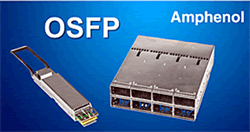 Amphenol featured the new (Octal) OSFP pluggable copper and fiber I/O connector system that features eight 50 Gb//s PAM4 differential pairs to support 400 Gb/s applications. Copper cable assemblies to 3 meters are available. Belly-to-belly and stacked PCB cage assemblies will be available. Amphenol is shipping 25Gb versions now, with 50Gb parts available in 2018. Foxconn Interconnect Technologies, Fujitsu, Molex, TE Connectivity and Yamaichi also belong to the OSFP MSA, with Molex and TE also announcing the tooling of this connector.
Amphenol featured the new (Octal) OSFP pluggable copper and fiber I/O connector system that features eight 50 Gb//s PAM4 differential pairs to support 400 Gb/s applications. Copper cable assemblies to 3 meters are available. Belly-to-belly and stacked PCB cage assemblies will be available. Amphenol is shipping 25Gb versions now, with 50Gb parts available in 2018. Foxconn Interconnect Technologies, Fujitsu, Molex, TE Connectivity and Yamaichi also belong to the OSFP MSA, with Molex and TE also announcing the tooling of this connector.
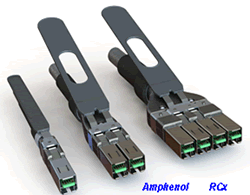 In order to address short run (<3 meter) jumper applications, Amphenol also showed the new RCx pluggable interface. This highly modular passive interconnect is available in single, double and four port versions each rated to 25 Gb/s per port and is focused on low-cost copper cable only applications.
In order to address short run (<3 meter) jumper applications, Amphenol also showed the new RCx pluggable interface. This highly modular passive interconnect is available in single, double and four port versions each rated to 25 Gb/s per port and is focused on low-cost copper cable only applications.
The Molex booth featured a variety of high-speed interfaces and live demonstrations including QSFP double density connectors, the new SpeedMezz mezzanine connector rated up to 56 Gb/s, the Impel+ backplane connector rated to 56Gb PAM4, and the Impulse Orthogonal Direct connector rated to 56Gb NRZ /112 Gb PAM4.
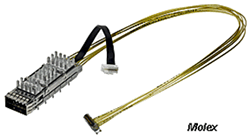 The BiPass I/O connector is an example of replacing high-speed PCB traces with twinax copper cables. This BiPass I/O connector is an example of replacing high-speed PCB traces with twinax copper cables. This ASIC or SERDES to zQSFP connector eliminates routing high-speed traces to the I/O, simplifies board design and reduces the need for advanced PCB laminates.
The BiPass I/O connector is an example of replacing high-speed PCB traces with twinax copper cables. This BiPass I/O connector is an example of replacing high-speed PCB traces with twinax copper cables. This ASIC or SERDES to zQSFP connector eliminates routing high-speed traces to the I/O, simplifies board design and reduces the need for advanced PCB laminates.
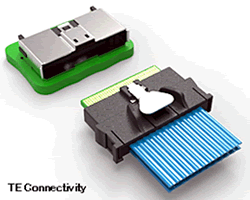 The TE Connectivity booth included multiple demonstrations of high-speed backplane and I/O solutions. In addition to TE releasing their OSFP pluggable connector, several new and upgraded connectors were displayed. The Sliver internal connector announced last year was demonstrated running 25 Gb/s NRZ over three meters of twinax cable. Sliver is targeting upcoming 16 Gb PCIe Gen 4 applications. The long-range objective is to achieve 112 Gb PAM4 per differential pair.
The TE Connectivity booth included multiple demonstrations of high-speed backplane and I/O solutions. In addition to TE releasing their OSFP pluggable connector, several new and upgraded connectors were displayed. The Sliver internal connector announced last year was demonstrated running 25 Gb/s NRZ over three meters of twinax cable. Sliver is targeting upcoming 16 Gb PCIe Gen 4 applications. The long-range objective is to achieve 112 Gb PAM4 per differential pair.
The Micro QSFP offers four channels of 25 Gb in a package slightly larger than original SFP. Molex is a second source.
 The Strada Whisper backplane connector system is now rated to 56 Gb/s PAM4, and may evolve to 56 Gb/s NRZ. A new Strada Whisper MEZZ connector was announced and rated to 56 Gb, PAM 4.
The Strada Whisper backplane connector system is now rated to 56 Gb/s PAM4, and may evolve to 56 Gb/s NRZ. A new Strada Whisper MEZZ connector was announced and rated to 56 Gb, PAM 4.
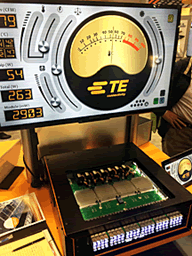
Recognizing increasing concern over thermal management in densely packaged systems, TE showed a simulation tool that demonstrated the ability of their high-speed pluggables to effectively manage the resulting heat.
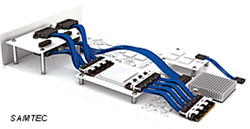 Samtec is promoting their silicon to silicon system solution to support next generation speed and density requirements. They continue to fill out their line of ExaMAX backplane connectors with vertical and right-angle configurations now rated to 56 Gb NRZ.
Samtec is promoting their silicon to silicon system solution to support next generation speed and density requirements. They continue to fill out their line of ExaMAX backplane connectors with vertical and right-angle configurations now rated to 56 Gb NRZ.
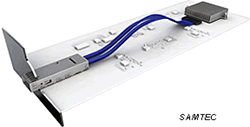 The advantages of their “Flyover” cable concept emphasized the use of twinax cable including improved signal integrity with longer reach at 28 Gb/s. These cables also eliminate the need for expensive PCB materials and extra layers as well as the cost of retimers.
The advantages of their “Flyover” cable concept emphasized the use of twinax cable including improved signal integrity with longer reach at 28 Gb/s. These cables also eliminate the need for expensive PCB materials and extra layers as well as the cost of retimers.
Systems can be upgraded in the future by simply replacing the twinax cable with fiber optic cables. Several new configurations were displayed including a QSFP direct attach version.
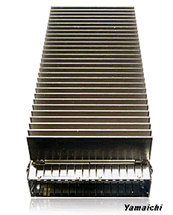 Yamaichi featured their expanding line of CFP host connectors and cage assemblies including CFP 2, 4 and 8 with data rates to 56 Gb/s PAM4. Yamaichi also announced CFP2-64G connectors to support future CFP2-ACO (Analog Coherent Optics) module requirements. They also showed SFP28 and QSFP28 copper cable pluggables for shorter reach applications.
Yamaichi featured their expanding line of CFP host connectors and cage assemblies including CFP 2, 4 and 8 with data rates to 56 Gb/s PAM4. Yamaichi also announced CFP2-64G connectors to support future CFP2-ACO (Analog Coherent Optics) module requirements. They also showed SFP28 and QSFP28 copper cable pluggables for shorter reach applications.
Additional new products on display included the expanding line of Hirose board-to-board connectors such as the IT9 family designed to support 28+ Gb applications. Meritec showed a 40 Gb active optical module utilizing their successful Hercules copper connector. Carlisle introduced their AltaVel 25 Gb digital connector for board-to-board and board-to-cable applications that features an open pin field for design flexibility. It is available with or without metal shells and is rated to 10,000 mating cycles. Leoni featured their expanded lines of copper pluggable connectors including the new QSFP double density and OSFP copper interfaces.
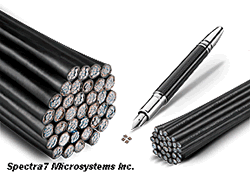 One of the most innovative solutions to solving the problem of bulky copper cables came from Spectra 7 Microsystems. Most high-speed I/O twinax cables use AWG 26 conductors to minimize skin effect. Spectra 7 has developed the “GaugeChanger Plus” chip that is integrated into a connector paddleboard. This active board is installed at one end of a high-speed cable assembly and then plugged into a device that analyzes the cable, and burns corrections permanently into the chip.
One of the most innovative solutions to solving the problem of bulky copper cables came from Spectra 7 Microsystems. Most high-speed I/O twinax cables use AWG 26 conductors to minimize skin effect. Spectra 7 has developed the “GaugeChanger Plus” chip that is integrated into a connector paddleboard. This active board is installed at one end of a high-speed cable assembly and then plugged into a device that analyzes the cable, and burns corrections permanently into the chip.
Insertion loss in minimized, allowing the use of AWG 38 conductors greatly reducing the diameter of a cable bundle as well as extending reach. This “smart” copper cable approach is a cost effective alternative to expensive fiber optic or active copper cables.
Spectra 7 is sampling internal paddleboards that incorporate this chip in SFP, QSFP, MiniSAS HD, PCIe, OSFP, and other High Speed I/O configurations.
Although several entirely new high-speed interconnects were announced at DesignCon 2017, the majority of products displayed continue to illustrate the progression of constant refinement and upgrading of performance and signal density. Product families continue to be filled out with flagship backplane connector families expanding with midplane orthogonal direct and cable backplane options. Internal and I/O connectors are becoming denser and faster. One would expect that we are reaching the limits of what more can be done to improve performance, but vendors expressed confidence that at least one or two more generations of high-speed connectors will be introduced in the future.

Recently posted:
[related_posts limit=”10″]
- Optics Outpace Copper at OFC 2024 - April 16, 2024
- Digital Lighting Enhances your Theatrical Experience - March 5, 2024
- DesignCon 2024 in Review - February 13, 2024





